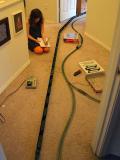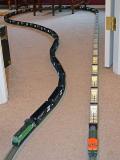
| Home | Open Account | Help | 218 users online |
|
Member Login
Discussion
Media SharingHostingLibrarySite Info |
Western Railroad Discussion > Remember the DPU science project?Date: 04/13/13 14:02 Remember the DPU science project? Author: pmack First off, thanks for helping us get started and providing some background, especially the couple engineers that PMed us.
For our experiment, we laid out a 70 foot loop of HO scale EZ track. It was very curvy on one side and as straight as we could make it on the other. Our train was two Athearn SWs and 36 coal hoppers. At first we were just going to see how many cars different locomotive configurations would let us move but there were too many variables including how clean the track and wheels were. When they were cleaned, we had to take off half a dozen cars. Instead we measured how long it took for the train to pass a point on the straight side and compared it to how long it took the train to pass a point on the crooked side. We noticed the time on the straight track was about the same no matter where the locomotives were. Not surprisingly, both locomotives on the front had the biggest discrepancy, indicating it was the least efficient in the curves. The next slowest/least efficient arrangement was with the second locomotive exactly in the middle of the train. The trains with locomotives at either end and the one with the second 3/4 back were the most efficient. We timed the trains for 5 laps and those two arrangements had identical times. We also tried an unprototypical arrangement of 9cars, a loco, 18 cars, second loco, and the last 9 cars and it did almost as well. If our house was bigger and we could have had a longer straight we would have seen even bigger differences in the times between straight and curved. As it was, our train was only 6 or 7 feet shorter than the straight so while we were measuring it on the straight portion, it traveled almost its whole length on the curves. Here are a couple photos of the setup and testing. Thanks again, Paul and Laura Photo 1, timing and recording. We used the lap timer on an iPad. 2 Earlier in the test setup, looking toward the western turnback loop. 3 An early test train before we cleaned the wheels (thus the 47 cars) looking toward the eastern loop. Edited 1 time(s). Last edit at 04/13/13 14:09 by pmack.    Date: 04/13/13 14:07 Re: Remember the DPU science project? Author: Funnelcam This is awesome. My daughter is about to be 4 and loves trains. Good luck on the project and most of all thanks for the great idea! I can now spend some money on a bunch of track and chalk it up to "education" ;)
Mike Cyr Holiday, FL Jointed Rail Productions Date: 04/13/13 15:35 Re: Remember the DPU science project? Author: icancmp193 Much better than the baking soda volcano.
Tom Y Date: 04/13/13 16:10 Re: Remember the DPU science project? Author: ns1000 That is sooooo COOL!!!!!!
Date: 04/13/13 16:18 Re: Remember the DPU science project? Author: DocJones Looks like you guys are doing a lot better than U.P.
Have fun, be safe, Bruce "Doc" Jones Sierra Madre CA Date: 04/13/13 16:46 Re: Remember the DPU science project? Author: mtnwestrail Thanks for the follow up. As someone who has been in science fairs and now judges them yearly this is a project that would score highly for being creative and not just regurgitating something out of a book. Be sure to post the final report. ;-]
Paul Birkholz Sheridan, WY Date: 04/13/13 16:53 Re: Remember the DPU science project? Author: MojaveBill Wow!!
Bill Deaver Tehachapi, CA Date: 04/13/13 17:04 Re: Remember the DPU science project? Author: Western_Star Nice!!
Date: 04/13/13 17:06 Re: Remember the DPU science project? Author: Yarddogh A Family Project . . : >) . . That's pretty cool . . as were the results you stated.
Date: 04/13/13 17:07 Re: Remember the DPU science project? Author: mtnwestrail Another variable you could add to it is a hill which is where the DPU technology really seems to shine.
Paul Birkholz Sheridan, WY Date: 04/13/13 19:30 Re: Remember the DPU science project? Author: pmack Paul, we thought about a hill but unfortunately or fortunately, depending on your perspective, our floor is very flat.
When we did the display, instead of a lot of printing and cutting and gluing to make the poster, we put it in Photoshop and made large photos of everything and printed 2 24" wide prints at Kinkos. It was well worth the extra cost. Here's the lead photo, a coke train nearing Roosevelt, WA. July 14, 2012.  Date: 04/13/13 19:40 Re: Remember the DPU science project? Author: mtnwestrail Excellent idea, but points off because you did the PS work, right? ;-P I was thinking with that snap track you could build a very slight hill using pencils, dowels, whatever, and keep it pretty simple. That could be next year!
Paul Birkholz Sheridan, WY Date: 04/13/13 20:26 Re: Remember the DPU science project? Author: pmack mtnwestrail Wrote:
------------------------------------------------------- > Excellent idea, but points off because you did the > PS work, right? ;-P I was thinking with that snap > track you could build a very slight hill using > pencils, dowels, whatever, and keep it pretty > simple. That could be next year! I did but under direct supervision. At least most of it, some of it I was on my own. Date: 04/13/13 23:33 Re: Remember the DPU science project? Author: funnelfan Neat project. But I'm surprised the mid train setup did so poorly. Based on what I know, the further the cars are from the locomotive, the more drag they create against the rail in curves. So that would lead me to believe that the DPU on the end should be second worst, and the mid train should be better. The ideal setup would be a DPU 2/3rds back in the track, so each 1/3 of the train has identical forces. Actually I did something similar years ago on the Corvallis Society of Model Engineer's layout trying to find the ideal location for a two unit helper set in a 50 car train. The grades and curves were such, that anything much over 25~30 cars would stringline. The setup was a BN F45 and two SP SD40T-2's in the lead, and a BN and MRL SD40-2 as helpers. These were all Athearn and non-DCC (about 1994 timeframe). The grade was around 3~4%. Helpers on the end of the train didn't work, as the forces in the center of the train were still too great. Mid train helpers worked somewhat, but were still prone to derailments because the helpers were right at their pulling limits, and the slack was running in and out on the front coupler of the helpers. What worked best was 2/3rds back. That way the helpers were pushing several cars ahead and that created a floating buffer ahead of the helpers. The point where the couplers went from slack to taunt changed as the train went through various curves and grade changes, but so long as the slack didn't run out all the way back to the helper set, the train wouldn't stringline.
Ted Curphey Ontario, OR Date: 04/14/13 14:39 Re: Remember the DPU science project? Author: trainman630 >
> If our house was bigger and we could have had a > longer straight we would have seen even bigger > differences in the times between straight and > curved. As it was, our train was only 6 or 7 feet > shorter than the straight so while we were > measuring it on the straight portion, it traveled > almost its whole length on the curves. Next years science project; how to get a bigger house so you can prove the cost efficiencies of CTC! |